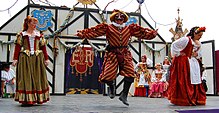Renaissance Pleasure Faire of Southern California
| Renaissance Pleasure Faire of Southern California | |
|---|---|
 Renaissance Pleasure Faire of Southern California, April 2011 | |
| Genre | Renaissance faire |
| Dates | April - May |
| Location(s) | Irwindale, California |
| Inaugurated | 1962 |
| Attendance | 250,000 (average) |
| Stages | 11 |
| Website | www.renfair.com/socal/ |
The Renaissance Pleasure Faire of Southern California (RPFS) is the first modern Renaissance faire to occur in America. It opened in the spring of 1963 and has been an annual event since then.[1] Presently owned by Renaissance Entertainment Productions (REP), it is a commercial reenactment of a 1580s[2] market faire at Port Deptford,[3] a waterfront town in Elizabethan England. The Faire is generally open from the first weekend of April through the weekend before Memorial Day.
Contents
1 History
2 Attire
3 See also
4 Further reading
5 References
6 External links
History
Created by Ron Patterson and Phyllis Patterson, the radio station KPFK, [4] and the nonprofit organization Living History Center (LHC),[5] the first Renaissance Pleasure Faire of Southern California (RPFS) was first staged at Agoura Hills in the spring of 1963. The first Renaissance Pleasure Faire of Northern California (RPFN) occurred in the fall of 1967.
In 1989, RPFS was moved to the Glen Helen Regional Park in Devore, California; then to its present location, the Santa Fe Dam Recreation Area in Irwindale, California. In 1999, RPFN was moved to the Nut Tree in Vacaville, California and later was relocated again to Casa de Fruta in the Hollister/Gilroy area south of San Jose.
In 1993 RPFS was purchased by Renaissance Entertainment Corp (REC), a for-profit corporation; and later by its current owners, Renaissance Entertainment Productions (REP) (also a for-profit corporation), under whom the Faire has become more family-oriented.[5][6]
Attire
The costumes worn by RPFS's actors are styled after those of the period of Elizabeth I (1558-1603) and must pass a rigorous approval process ensuring their authenticity. There are five general classes of attire: Yeoman, Merchant, Gentry, Nobility and Military. Other cultures represented include Scots, Italians, Germans, Spaniards, and various Arabian cultures. There are also performance groups such as mongers, Puritans, adventurers and inventors, which are organized into guilds. Visitors, commonly known as patrons, are encouraged to wear Renaissance-inspired costumes, but are not required to adhere to the Elizabethan period.[7]
See also
- Renaissance fair
- List of Renaissance fairs
- Reenactment
- Jousting
- Society for Creative Anachronism
- List of open air and living history museums in the United States
Further reading
Slotnik, Daniel E. (11 June 2014). "Phyllis Patterson, who revived the 16th century, dies at 82". The New York Times..mw-parser-output cite.citationfont-style:inherit.mw-parser-output qquotes:"""""""'""'".mw-parser-output code.cs1-codecolor:inherit;background:inherit;border:inherit;padding:inherit.mw-parser-output .cs1-lock-free abackground:url("//upload.wikimedia.org/wikipedia/commons/thumb/6/65/Lock-green.svg/9px-Lock-green.svg.png")no-repeat;background-position:right .1em center.mw-parser-output .cs1-lock-limited a,.mw-parser-output .cs1-lock-registration abackground:url("//upload.wikimedia.org/wikipedia/commons/thumb/d/d6/Lock-gray-alt-2.svg/9px-Lock-gray-alt-2.svg.png")no-repeat;background-position:right .1em center.mw-parser-output .cs1-lock-subscription abackground:url("//upload.wikimedia.org/wikipedia/commons/thumb/a/aa/Lock-red-alt-2.svg/9px-Lock-red-alt-2.svg.png")no-repeat;background-position:right .1em center.mw-parser-output .cs1-subscription,.mw-parser-output .cs1-registrationcolor:#555.mw-parser-output .cs1-subscription span,.mw-parser-output .cs1-registration spanborder-bottom:1px dotted;cursor:help.mw-parser-output .cs1-hidden-errordisplay:none;font-size:100%.mw-parser-output .cs1-visible-errorfont-size:100%.mw-parser-output .cs1-subscription,.mw-parser-output .cs1-registration,.mw-parser-output .cs1-formatfont-size:95%.mw-parser-output .cs1-kern-left,.mw-parser-output .cs1-kern-wl-leftpadding-left:0.2em.mw-parser-output .cs1-kern-right,.mw-parser-output .cs1-kern-wl-rightpadding-right:0.2em
Williams, Ken (1992-06-04). "Weekends of yore: Renaissance Pleasure Faire celebrates the days and knights of merry olde England". Los Angeles Times.
Stewart, Zan (1987-04-19). "Hear ye, hear ye: 'tis faire time". Los Angeles Times.
Fox, Margalit (2011-01-30). "Ron Patterson, renaissance (fair) man, dies at 80". The New York Times.
References
^ Sneed, Richard J. (1987). The Faire: Photographs and History of the Renaissance Pleasure Faire from 1963 onwards. Santa Cruz, CA: The Good Book Press. OCLC 26491008.
^ "REC California Faire Specifics". renfaire.com. Retrieved 2008-05-10.
^ "Entertainment 2013". renfair.com. Archived from the original on 2013-05-17. Retrieved 2013-05-13.
^ "Fairest Of the Faire".
^ ab "RPFI California Faire History". renfaire.com. Retrieved 2008-05-10.
^ Talavera, E. (2007-05-16). "Renaissance Pleasure Faire is for young and old". Lifestyles. El Paisano. Whittier, CA: Rio Hondo College. Archived from the original on 2008-12-02. Retrieved 2008-05-10.
^ Mills, Michelle J. (2008-03-29). "Come play at the Faire". Pasadena Star-News. Archived from the original on 2008-06-24. Retrieved 2008-05-10.
External links
- Official website
This festival-related article is a stub. You can help Wikipedia by expanding it. |
